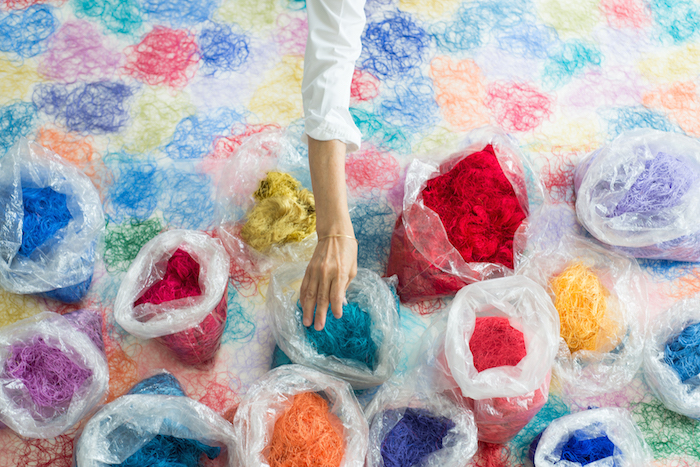MEDIA CONTACTS:
Brett Zongker: bzongker gwu [dot] edu (bzongker[at]gwu[dot]edu), 202-994-6466
gwu [dot] edu (bzongker[at]gwu[dot]edu), 202-994-6466
Maralee Csellar: csellar gwu [dot] edu (csellar[at]gwu[dot]edu), 202-994-7564
gwu [dot] edu (csellar[at]gwu[dot]edu), 202-994-7564
WASHINGTON (Aug. 31, 2017)—Textile and apparel manufacturing is one of the most polluting industries in the world, and a new exhibition at the George Washington University Museum and The Textile Museum will explore the work of three innovative designers focused on sustainability and reducing waste in the design process. “Scraps: Fashion, Textiles and Creative Reuse” will be on view Sept. 2 through Jan. 7, 2018.
While waste is produced at nearly every step of the production chain for textiles and clothing, the designers highlighted in the exhibition are focused on using scraps and cast-offs to create desirable products. The exhibition showcases the work of Luisa Cevese, founder of the Milan-based design studio Riedizioni; Christina Kim, founder of Los Angeles-based brand Dosa; and Reiko Sudo, co-founder of Tokyo textile design firm Nuno.
“‘Scraps’ reveals the environmental impact of the global fashion industry and offers creative solutions by leading designers who are dedicated to reducing waste,” said John Wetenhall, director of the George Washington University Museum and The Textile Museum. “This exhibition supports the George Washington University's longstanding commitment to sustainability and also showcases our museum's expanding focus on contemporary textile art.”
More than 40 works are featured in the exhibition to explore key areas of sustainability, including efficient use of materials, the preservation of local craft traditions and the integration of new technologies in recycling. The works on view include accessories and handbags fashioned from silk selvage scraps by Cevese; a variety of fabrics woven from kibiso, a luxury fiber Sudo developed from discarded parts of the silk cocoon; and decorative panels produced from recycled jamdani saris by Kim. Some creations are the result of zero-waste designs where textiles were cut so there would be no scraps and no waste.
“Scraps” was organized by the Cooper Hewitt, Smithsonian Design Museum in New York City. The exhibition in Washington is the only other venue for the show after its debut.
“The Washington, D.C., area has an extensive sustainable, reuse-oriented textile community,” said Camille Ann Brewer, curator of contemporary art at the George Washington University Museum and The Textile Museum. “We look forward to hosting visitors for educational programs that explore different facets of pre- and post-consumer waste.”
The museum’s 38th annual Celebration of Textiles festival Sept. 2-3 will feature the art of recycling this year. The free festival will include hands-on activities such as weaving with recycled materials; demonstrations by local fiber artists; and live music and dance in conjunction with the “Scraps” exhibition. The museum will continue exploring sustainable fashion through the fall by hosting a fashion show Oct. 5 featuring designs created by Howard University fashion design students. Additional public programs will be held throughout the duration of the exhibition. Both Sudo and Kim will present programs at the museum, along with zero-waste designer Timo Rissanen.
Featured Designers
Luisa Cevese appropriates production waste to create one-of-a-kind fashion and home accessories. Her designs for Riedizioni, which she founded in 1996, are made with scraps gathered from various phases of the textile production process, which she encases in translucent polyurethane. A self-taught designer, Cevese began creating textiles for fashion and interiors in 1984, providing work for companies such as Dolce & Gabbana, Hermès, Chanel and Comme des Garçons.
Christina Kim’s fashion brand, Dosa, uses a system-wide approach to reuse and recycling, including using cutting-room waste to create new products. She draws on traditional, handcrafted and labor-intensive textile practices around the world, particularly India and Oaxaca, working with local artisans and engaging them in long-term collaborations. Widely recognized for her global and sustainable design practices, Kim was named by Time magazine as one of its Innovators of the Year in 2003 and received the “Innovation in Craft” Award by Aid to Artisans in 2006.
In 1984, Reiko Sudo co-founded Nuno, a textile design firm at the forefront of innovation that combines the Japanese handcraft tradition with advanced technologies. Over the years Sudo has proposed different initiatives to reduce waste, such as recycling polyester garments and using leftover scraps to create new textiles. Nuno’s fabrics have been featured in exhibitions around the world, including the Museum of Modern Art, New York; National Museum of Modern Art in Tokyo; The Textile Museum in Washington, D.C., and Fowler Museum at UCLA in Los Angeles, among many others.
Current Exhibitions
“A Collector’s Vision: Selections from the Albert H. Small Washingtoniana Collection” displays maps, letters, prints, and artifacts from the museum’s Albert H. Small Washingtoniana Collection, including recent acquisitions and rare treasures. Mr. Small donated his unrivaled Washingtoniana collection—nearly 60 years in the making—to GW in 2011. The collection documents the formation, development and history of Washington from the 18th to the mid-20th century and includes more than 1,000 maps and prints, rare letters, photographs and drawings.
In the exhibition “Foundations for a Nation: Architectural Images from the Albert H. Small Washingtoniana Collection,” historical images reveal how public competitions, presidential preferences and unanticipated historical events shaped two of Washington’s most iconic landmarks: the U.S. Capitol and White House. The exhibition is open through Oct. 16.
Visit the museum’s website for the latest information on exhibitions and educational programs: www.museum.gwu.edu.
-GW-


